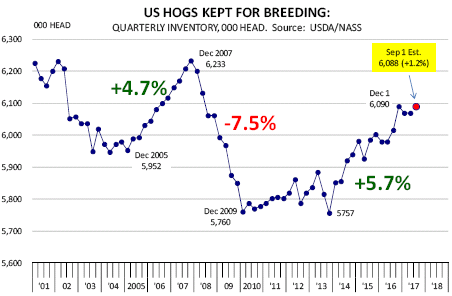



CME: Aggressive Sale in Hog Futures in Last Few Weeks
US - The results of the quarterly USDA "Hogs and Pigs" inventory survey will be released on Thursday, 28 September, reports Steiner Consulting Group, DLR Division, Inc.Analysts polled by Urner Barry ahead of the report for the most part agree that there were more hogs on the ground on 1 September than the previous year. On average they expect the inventory to show a 2.5 per cent increase but, as you can see in the following table, there is a fair amount of disagreement as to how large those inventories are.

Futures have sold off quite aggressively in the last few weeks following the sharp break in cash hog prices and expectations of significant supply pressure in the short term. It appears to us that participants have finally come to grips with the fact that hog/pork supplies will be quite heavy in the short term and lower prices are necessary to keep this supply moving through the supply chain.
But as the fall/winter spreads indicate, market participants expect the situation to normalize by the end of this year when hog numbers seasonally decline and the two new packing plants start operating more efficiently. October hog futures are now down 22 per cent from where they were priced in mid-August while February futures have declined only 8 per cent during the same time frame.
A few things to watch in the upcoming report:
How big is the supply of 120-179 lb. hogs? Weekly hog slaughter between mid-Oct and mid-Nov 2016 averaged almost 2.5MM head/week. Analysts expect this segment of the inventory to be up 2.9 per cent compared to a year ago which would imply weekly slaughter near 2.57MM. In the June survey this segment was implied to be over 3 per cent, thus there is always the risk that we could see a few more hogs in this category. So far slaughter numbers have tracked under the June survey results. The guessing game at this time is whether slaughter will continue to track under the survey implied numbers or if producers delayed breeding so as to time marketings with the opening of the new plants.

What will the Jun-Aug pig crop look like? The last survey report pegged the farrowings for this period to be just 0.2 per cent higher than the previous year, which appeared rather low considering the size of the breeding herd. Coming into this report analysts think farrowings for this period were about 1 per cent higher and with another 0.8 per cent coming from higher pigs per litter the pig crop for this period is now expected to be 1.8 per cent higher than a year ago. These are pigs that will come to market between Dec-Feb and any surprises in this number will mostly affect the Feb contract.
Farrowing intention numbers have been quite poor predictors of final pig crop. As the June pig crop estimates show, analysts think that the USDA survey will continue its trend of big revisions to previous farrowing estimates. Therefore, how much weight should market participants put on the Sep-Nov and Dec-Feb farrowings? Farrowing intentions for Sep-Nov are expected to be up 0.6 per cent and (this is a correction from our earlier report) Dec- Feb is expected to be up just 0.1 per cent. This would imply summer supplies up only by a percentage point or so.
The size of the breeding herd remains a key factor. Analysts expect the breeding herd to be up 1.2 per cent from a year ago but only modestly higher than it was in June. Given the lack of significant sow slaughter during Jun- Aug and strong hog prices during the quarter, this projection does not seem like such a stretch. A surprise in the size of the breeding herd, either up or down, would mostly impact spring/summer contracts. In the short term market participants will look to price the supply effects from the latest survey. However, they are aware that continued expansion in capacity will, over time, narrow the meat spread and reflect this in hog prices for late spring and summer of 2018.








